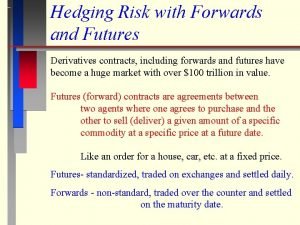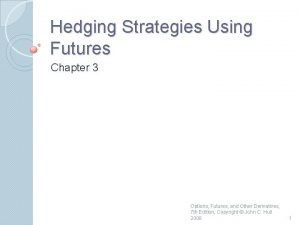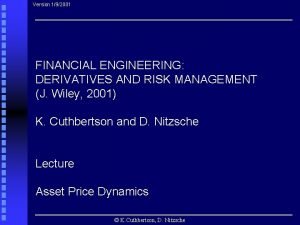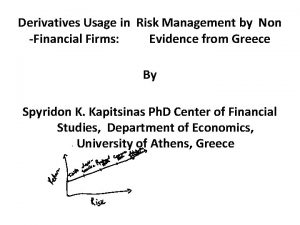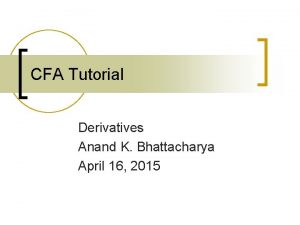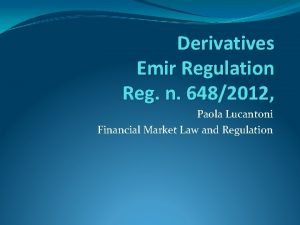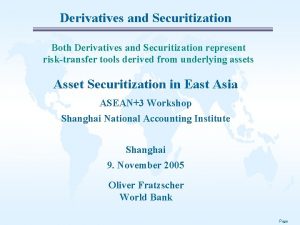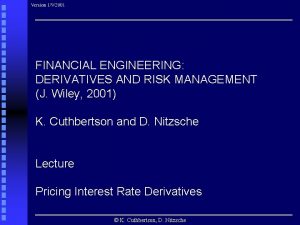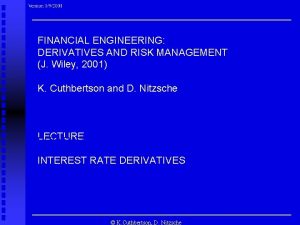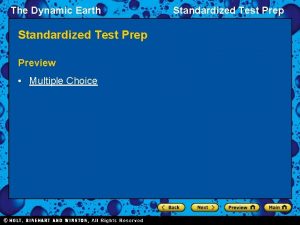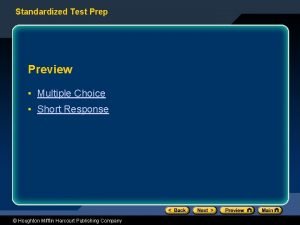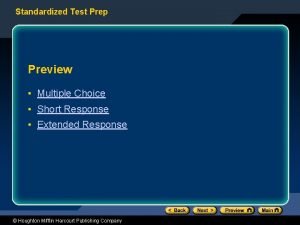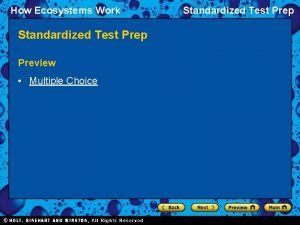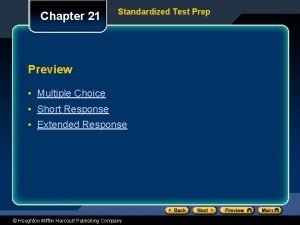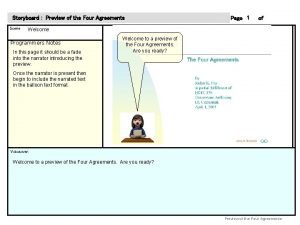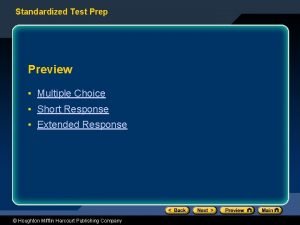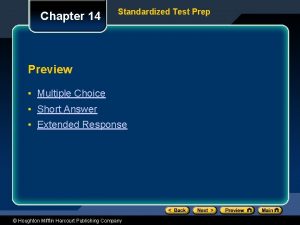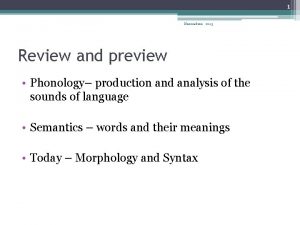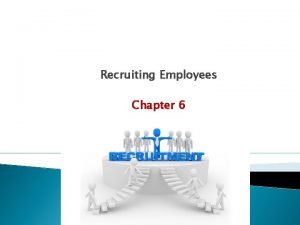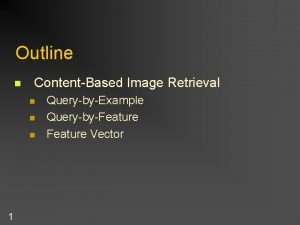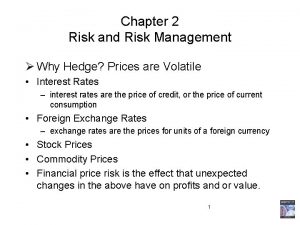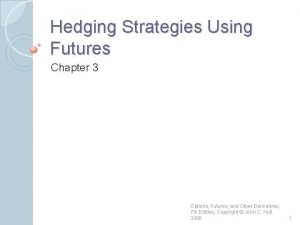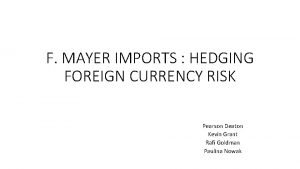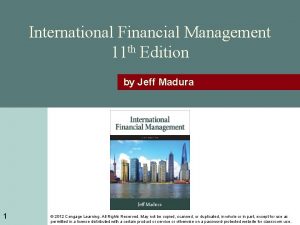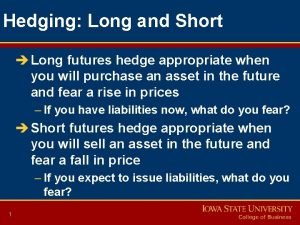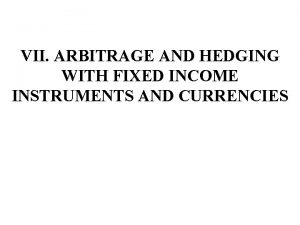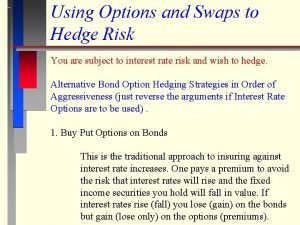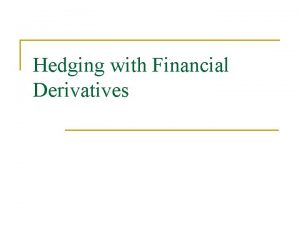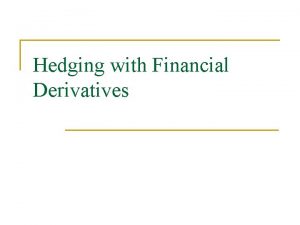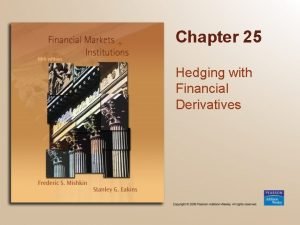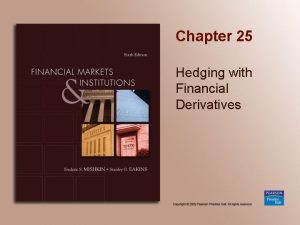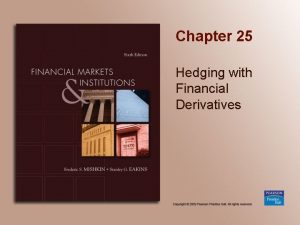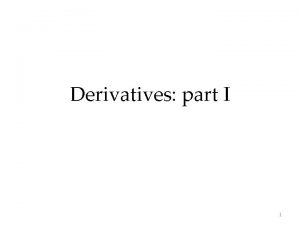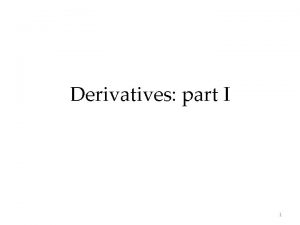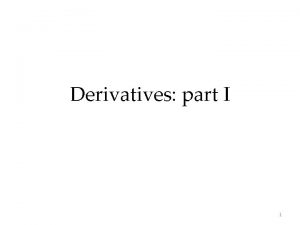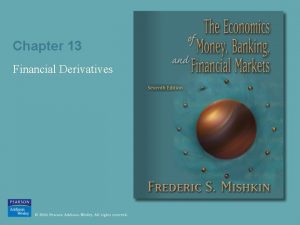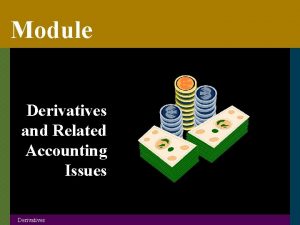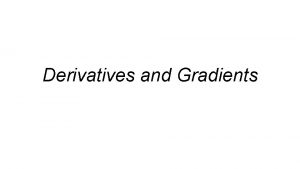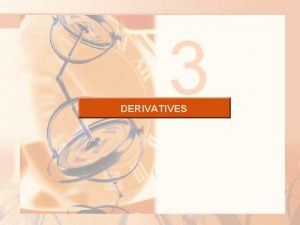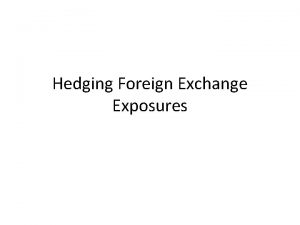Chapter 25 Hedging with Financial Derivatives Chapter Preview






























































- Slides: 62

Chapter 25 Hedging with Financial Derivatives

Chapter Preview Starting in the 1970 s, the world became a riskier place for financial institutions. Interest rate volatility increased, as did the stock and bond markets. Financial innovation helped with the development of derivatives. But if improperly used, derivatives can dramatically increase the risk institutions face. Copyright © 2009 Pearson Prentice Hall. All rights reserved. 2

Chapter Preview • In this chapter, we look at the most important derivatives that managers of financial institution use to manage risk. We examine how the markets for these derivatives work and how the products are used by financial managers to reduce risk. Topics include: – Hedging – Forward Markets – Financial Futures Markets Copyright © 2009 Pearson Prentice Hall. All rights reserved. 3

Chapter Preview (cont. ) – Stock Index Futures – Options – Interest-Rate Swaps – Credit Derivatives Copyright © 2009 Pearson Prentice Hall. All rights reserved. 4

Hedging • Hedging involves engaging in a financial transaction that reduces or eliminates risk. • Definitions – long position: an asset which is purchased or owned – short position: an asset which must be delivered to a third party as a future date, or an asset which is borrowed and sold, but must be replaced in the future Copyright © 2009 Pearson Prentice Hall. All rights reserved. 5

Hedging • Hedging risk involves engaging in a financial transaction that offsets a long position by taking an additional short position, or offsets a short position by taking an additional long position. • We will examine how this is specifically accomplished in different financial markets. Copyright © 2009 Pearson Prentice Hall. All rights reserved. 6

Forward Markets • Forward contracts are agreements by two parties to engage in a financial transaction at a future point in time. Although the contract can be written however the parties want, the contact usually includes: – The exact assets to be delivered by one party, including the location of delivery – The price paid for the assets by the other party – The date when the assets and cash will be exchanged Copyright © 2009 Pearson Prentice Hall. All rights reserved. 7

Forward Markets • An Example of an Interest-Rate Contract – First National Bank agrees to deliver $5 million in face value of 6% Treasury bonds maturing in 2023 – Rock Solid Insurance Company agrees to pay $5 million for the bonds – FNB and Rock Solid agree to complete the transaction one year from today at the FNB headquarters in town Copyright © 2009 Pearson Prentice Hall. All rights reserved. 8

Forward Markets • Long Position – Agree to buy securities at future date – Hedges by locking in future interest rate of funds coming in future, avoiding rate decreases • Short Position – Agree to sell securities at future date – Hedges by reducing price risk from increases in interest rates if holding bonds Copyright © 2009 Pearson Prentice Hall. All rights reserved. 9

Forward Markets • Pros 1. Flexible • Cons 1. Lack of liquidity: hard to find a counter-party and thin or non-existent secondary market 2. Subject to default risk—requires information to screen good from bad risk Copyright © 2009 Pearson Prentice Hall. All rights reserved. 10

Financial Futures Markets • Financial futures contracts are similar to forward contracts in that they are an agreement by two parties to engage in a financial transaction at a future point in time. However, they differ from forward contracts in several significant ways. Copyright © 2009 Pearson Prentice Hall. All rights reserved. 11

Financial Futures Markets • Financial Futures Contract 1. Specifies delivery of type of security at future date 2. Arbitrage: at expiration date, price of contract = price of the underlying asset delivered 3. i , long contract has loss, short contract has profit 4. Hedging similar to forwards: micro versus macro hedge • Traded on Exchanges – Global competition regulated by CFTC Copyright © 2009 Pearson Prentice Hall. All rights reserved. Commodity Futures Options Trading, Inc. home page http: //www. usafutures. com/ 12

Example: Hedging Interest Rate Risk • A manager has a long position in Treasury bonds. She wishes to hedge again interest rate increases, and uses T-bond futures to do this: – Her portfolio is worth $5, 000 – Futures contracts have an underlying value of $100, 000, so she must short 50 contracts. Copyright © 2009 Pearson Prentice Hall. All rights reserved. 13

Example: Hedging Interest Rate Risk – As interest rates increase over the next 12 months, the value of the bond portfolio drops by almost $1, 000. – However, the T-bond contract also dropped almost $1, 000 in value, and the short position means the contact pays off that amount. – Losses in the spot T-bond market are offset by gains in the T-bond futures market. Copyright © 2009 Pearson Prentice Hall. All rights reserved. 14

Financial Futures Markets • The previous example is a micro hedge – hedging the value of a specific asset. Macro hedges involve hedging, for example, the entire value of a portfolio, or general prices for production inputs. Copyright © 2009 Pearson Prentice Hall. All rights reserved. 15

Financial Futures Markets • In the U. S. , futures are traded on the CBOT and the CME in Chicago, the NY Futures Exchange, and others. • They are regulated by the Commodity Futures Trading Commission. The most widely traded are listed in the Wall Street Journal, as we see on the next slide. Copyright © 2009 Pearson Prentice Hall. All rights reserved. 16

Following the News 17

Financial Futures Markets • The U. S. exchanges dominated the market for years. However, this isn’t true anymore. • The London Int’l Financial Futures Exchange trades Eurodollar futures • The Tokyo Stock Exchange trades Euroyen and gov’t bond futures • Several others as well, as seen next. Copyright © 2009 Pearson Prentice Hall. All rights reserved. 18

Widely Traded Financial Futures Contracts 19

Financial Futures Markets • Success of Futures Over Forwards 1. Futures are more liquid: standardized contracts that can be traded 2. Delivery of range of securities reduces the chance that a trader can corner the market 3. Mark to market daily: avoids default risk 4. Don't have to deliver: cash netting of positions Copyright © 2009 Pearson Prentice Hall. All rights reserved. 20

Hedging FX Risk • Example: A manufacturer expects to be paid 10 million euros in two months for the sale of equipment in Europe. Currently, 1 euro = $1, and the manufacturer would like to lock-in that exchange rate. Copyright © 2009 Pearson Prentice Hall. All rights reserved. 21

Hedging FX Risk • The manufacturer can use the FX futures market to accomplish this: 1. The manufacturer sells 10 million euros of futures contracts. Assuming that 1 contract is for $125, 000 in euros, the manufacturer takes as short position in 40 contracts. 2. The exchange will require the manufacturer to deposit cash into a margin account. For example, the exchange may require $2, 000 per contract, or $80, 000. Copyright © 2009 Pearson Prentice Hall. All rights reserved. 22

Hedging FX Risk 3. As the exchange rate fluctuates during the two months, the value of the margin account will fluctuate. If the value in the margin account falls too low, additional funds may be required. This is how the market is marked to market. If additional funds are not deposited when required, the position will be closed by the exchange. Copyright © 2009 Pearson Prentice Hall. All rights reserved. 23

Hedging FX Risk 4. Assume that actual exchange rate is 1 euro = $0. 96 at the end of the two months. The manufacturer receives the 10 million euros and exchanges them in the spot market for $9, 600, 000. 5. The manufacturer also closes the margin account, which has $480, 000 in it—$400, 000 for the changes in exchange rates plus the original $80, 000 required by the exchange (assumes no margin calls). 6. In the end, the manufacturer has the $10, 000 desired from the sale. Copyright © 2009 Pearson Prentice Hall. All rights reserved. 24

Stock Index Futures • Financial institution managers, particularly those that manage mutual funds, pension funds, and insurance companies, also need to assess their stock market risk, the risk that occurs due to fluctuations in equity market prices. • One instrument to hedge this risk is stock index futures. Copyright © 2009 Pearson Prentice Hall. All rights reserved. 25

Stock Index Futures • Stock index futures are a contract to buy or sell a particular stock index, starting at a given level. Contacts exist for most major indexes, including the S&P 500, Dow Jones Industrials, Russell 2000, etc. • The “best” stock futures contract to use is generally determined by the highest correlation between returns to a portfolio and returns to a particular index. Copyright © 2009 Pearson Prentice Hall. All rights reserved. 26

Hedging with Stock Index Futures • Example: Rock Solid has a stock portfolio worth $100 million, which tracks closely with the S&P 500. The portfolio manager fears that a decline is coming and what to completely hedge the value of the portfolio over the next year. If the S&P is currently at 1, 000, how is this accomplished? Copyright © 2009 Pearson Prentice Hall. All rights reserved. 27

Hedging with Stock Index Futures • Value of the S&P 500 Futures Contract = 250 index – currently 250 x 1, 000 = $250, 000 • To hedge $100 million of stocks that move 1 for 1 (perfect correlation) with S&P currently selling at 1000, you would: – sell $100 million of index futures = 400 contracts Copyright © 2009 Pearson Prentice Hall. All rights reserved. 28

Hedging with Stock Index Futures • Suppose after the year, the S&P 500 is at 900 and the portfolio is worth $90 million. – futures position is up $10 million • If instead, the S&P 500 is at 1100 and the portfolio is worth $110 million. – futures position is down $10 million • Either way, net position is $100 million Copyright © 2009 Pearson Prentice Hall. All rights reserved. 29

Hedging with Stock Index Futures • Note that the portfolio is protected from downside risk, the risk that the value in the portfolio will fall. However, to accomplish this, the manager has also eliminated any upside potential. • Now we will examine a hedging strategy that protects again downside risk, but does not sacrifice the upside. Of course, this comes at a price! Copyright © 2009 Pearson Prentice Hall. All rights reserved. 30

Options • Options Contract – Right to buy (call option) or sell (put option) an instrument at the exercise (strike) price up until expiration date (American) or on expiration date (European). • Options are available on a number of financial instruments, including individual stocks, stock indexes, etc. 31

Options • Hedging with Options – Buy same number of put option contracts as would sell of futures – Disadvantage: pay premium – Advantage: protected if i, gain • if i – Additional advantage if macro hedge: avoids accounting problems, no losses on option when i falls 32

Options 33

Factors Affecting Premium 1. Higher strike price, lower premium on call options and higher premium on put options. 2. Greater term to expiration, higher premiums for both call and put options. 3. Greater price volatility of underlying instrument, higher premiums for both call and put options. Copyright © 2009 Pearson Prentice Hall. All rights reserved. 34

Hedging with Options • Example: Rock Solid has a stock portfolio worth $100 million, which tracks closely with the S&P 500. The portfolio manager fears that a decline is coming and what to completely hedge the value of the portfolio against any downside risk. If the S&P is currently at 1, 000, how is this accomplished? Copyright © 2009 Pearson Prentice Hall. All rights reserved. 35

Hedging with Options • Value of the S&P 500 Option Contract = 100 index – currently 100 x 1, 000 = $100, 000 • To hedge $100 million of stocks that move 1 for 1 (perfect correlation) with S&P currently selling at 1000, you would: – buy $100 million of S&P put options = 1, 000 contracts Copyright © 2009 Pearson Prentice Hall. All rights reserved. 36

Hedging with Options • The premium would depend on the strike price. For example, a strike price of 950 might have a premium of $200 / contract, while a strike price of 900 might have a strike price of only $100. • Let’s assume Rock Solid chooses a strike price of 950. Then Rock Solid must pay $200, 000 for the position. This is non-refundable and comes out of the portfolio value (now only $99. 8 million). Copyright © 2009 Pearson Prentice Hall. All rights reserved. 37

Hedging with Options • Suppose after the year, the S&P 500 is at 900 and the portfolio is worth $89. 8 million. – options position is up $5 million (since 950 strike price) – in net, portfolio is worth $94. 8 million • If instead, the S&P 500 is at 1100 and the portfolio is worth $109. 8 million. – options position expires worthless, and portfolio is worth $109. 8 million Copyright © 2009 Pearson Prentice Hall. All rights reserved. 38

Hedging with Options • Note that the portfolio is protected from any downside risk (the risk that the value in the portfolio will fall ) in excess of $5 million. However, to accomplish this, the manager has to pay a premium upfront of $200, 000. Copyright © 2009 Pearson Prentice Hall. All rights reserved. 39

Interest-Rate Swaps • Interest-rate swaps involve the exchange of one set of interest payments for another set of interest payments, all denominated in the same currency. • Simplest type, called a plain vanilla swap, specifies (1) the rates being exchanged, (2) type of payments, and (3) notional amount. Copyright © 2009 Pearson Prentice Hall. All rights reserved. 40

Interest-Rate Swap Contract Example • Midwest Savings Bank wishes to hedge rate changes by entering into variable-rate contracts. • Friendly Finance Company wishes to hedge some of its variable-rate debt with some fixed-rate debt. • Notional principle of $1 million • Term of 10 years • Midwest SB swaps 7% payment for T-bill + 1% from Friendly Finance Company.

Interest-Rate Swap Contract Example 42

Hedging with Interest-Rate Swaps • Reduce interest-rate risk for both parties 1. Midwest converts $1 m of fixed rate assets to rate-sensitive assets, RSA, lowers GAP 2. Friendly Finance RSA, lowers GAP Copyright © 2009 Pearson Prentice Hall. All rights reserved. 43

Hedging with Interest-Rate Swaps • Advantages of swaps 1. Reduce risk, no change in balance-sheet 2. Longer term than futures or options • Disadvantages of swaps 1. Lack of liquidity 2. Subject to default risk • Financial intermediaries help reduce disadvantages of swaps (but at a cost!) Copyright © 2009 Pearson Prentice Hall. All rights reserved. 44

Credit Derivatives • Credit derivatives are a relatively new derivative offering payoffs based on changes in credit conditions along a variety of dimensions. Almost nonexistent twenty years ago, the notional amount of credit derivatives today is in the trillions. Copyright © 2009 Pearson Prentice Hall. All rights reserved. 45

Credit Derivatives • Credit derivatives can be generally categorized as credit options, credit swaps, and credit-linked notes. We will look at each of these in turn. Copyright © 2009 Pearson Prentice Hall. All rights reserved. 46

Credit Derivatives • Credit options are like other options, but payoffs are tied to changes in credit conditions. – Credit options on debt are tied to changes in credit ratings. – Credit options can also be tied to credit spreads. For example, the strike price can be a predetermined spread between AAA-rated and BBB-rated corporate debt. Copyright © 2009 Pearson Prentice Hall. All rights reserved. 47

Credit Derivatives • Credit options are like other options, but payoffs are tied to changes in credit conditions. – Credit options on debt are tied to changes in credit ratings. – Credit options can also be tied to credit spreads. For example, the strike price can be a predetermined spread between BBB-rated corporate debt and T-bonds. Copyright © 2009 Pearson Prentice Hall. All rights reserved. 48

Credit Derivatives • For example, suppose you wanted to issue $100, 000 in debt in six months, and your debt is expected to be rated single-A. Currently, A-rated debt is trading at 100 basis points above the Treasury. You could enter into a credit option on the spread, with a strike price of 100 basis points. Copyright © 2009 Pearson Prentice Hall. All rights reserved. 49

Credit Derivatives • If the spread widens, you will, of course, have to issue the debt at a higher-thanexpected interest rate. But the additional cost will be offset by the payoff from the option. Like any option, you will have to pay a premium upfront for this protection. Copyright © 2009 Pearson Prentice Hall. All rights reserved. 50

Credit Derivatives • Credit swaps involve, for example, swapping actual payments on similar-sized loan portfolios. This allows financial institutions to diversify portfolios while still allowing the lenders to specialize in local markets or particular industries. Copyright © 2009 Pearson Prentice Hall. All rights reserved. 51

Credit Derivatives • Another form of a credit swap, called a credit default swap, involves option-like payoffs when a basket of loans defaults. For example, the swap may payoff only after the 5 th bond in a bond portfolio defaults (or has some other bad credit event). Copyright © 2009 Pearson Prentice Hall. All rights reserved. 52

Credit Derivatives • Credit-linked notes combine a bond a credit option. Like any bond, it makes regular interest payments and a final payment including the face value. But the issuer has an option tied to a key variable. Copyright © 2009 Pearson Prentice Hall. All rights reserved. 53

Credit Derivatives • For example, GM might issue a bond with a 5% coupon rate. However, the covenants would stipulate that if an index of SUV sales falls by more than 10%, the coupon rate drops to 3%. This would be especially useful if GM was using the bond proceeds to build a new SUV plant. Copyright © 2009 Pearson Prentice Hall. All rights reserved. 54

Are derivatives a time bomb? • In the 2002 annual report for Berkshire Hathaway, Warren Buffett referred to derivatives (bought for speculation) as “…weapons of mass destruction. ” (although also noting that Berkshire uses derivatives). Is he right? Copyright © 2009 Pearson Prentice Hall. All rights reserved. 55

Are derivatives a time bomb? • There are three major concerns with the use of financial derivatives: – Derivatives allow financial institutions to increase their leverage (effectively changing their capital), possibly to take on more risk – Derivatives are too complicated – The derivative positions of some banks exceed their capital – the probability of failure has greatly increased Copyright © 2009 Pearson Prentice Hall. All rights reserved. 56

Are derivatives a time bomb? • As usual, the blanket comments are usually not accurate. For example, although the notional amount of derivatives exceeds capital, often these are offsetting positions on behalf of clients – the bank has no exposure. In other words, you have to look at each situation individually. Further, actual derivative losses by banks is small, despite a few news-worthy exceptions. Copyright © 2009 Pearson Prentice Hall. All rights reserved. 57

Are derivatives a time bomb? • In the end, derivatives do have their dangers. But so does hiring crooks to run a bank (Lincoln S&L ring a bell). But derivatives have changed the sophistication needed by both managers and regulators to understand the whole picture. Copyright © 2009 Pearson Prentice Hall. All rights reserved. 58

Chapter Summary • Hedging: the basic idea of entering into an offsetting contract to reduce or eliminate some type of risk was presented. • Forward Markets: the basic idea of contracts in this highly specialized market, as well as a simple example of eliminating risk was presented. Copyright © 2009 Pearson Prentice Hall. All rights reserved. 59

Chapter Summary (cont. ) • Financial Futures Markets: these exchange traded markets were presented, as well as their advantages over forward contacts. • Stock Index Futures: the specific application of stock index futures was presented, exploring their ability to reduce or eliminate risk for equity portfolios. Copyright © 2009 Pearson Prentice Hall. All rights reserved. 60

Chapter Summary (cont. ) • Options: these contracts, which give the buyer the right but not the obligation to act, were presented, as well as an example showing their costs. • Interest-Rate Swaps: the idea of trading fixed-rate interest payments for floating-rate payments was presented, as well as the pros and cons of such contracts. Copyright © 2009 Pearson Prentice Hall. All rights reserved. 61

Chapter Summary (cont. ) • Credit Derivatives: we examine this relatively new market for hedging the credit risk of portfolios and the dangers involved. Copyright © 2009 Pearson Prentice Hall. All rights reserved. 62
 Hedging in forward market
Hedging in forward market Hedge ratio formula
Hedge ratio formula Financial engineering derivatives and risk management
Financial engineering derivatives and risk management Non financial derivatives
Non financial derivatives Financial derivatives tutorial
Financial derivatives tutorial Paola lucantoni
Paola lucantoni Conclusion of financial derivatives
Conclusion of financial derivatives Financial engineering derivatives and risk management
Financial engineering derivatives and risk management Financial engineering derivatives and risk management
Financial engineering derivatives and risk management Thesis paragraph example
Thesis paragraph example Summary thesis statement
Summary thesis statement Test prep preview
Test prep preview Test prep preview
Test prep preview Test prep preview
Test prep preview Test prep preview
Test prep preview Sccm technical preview
Sccm technical preview Preview statement speech example
Preview statement speech example What is a preview statement
What is a preview statement Test prep preview
Test prep preview Nnn preview
Nnn preview The selection preview
The selection preview Test prep preview
Test prep preview The four agreements preview
The four agreements preview Test prep preview
Test prep preview Line between pada perintah column digunakan untuk membuat
Line between pada perintah column digunakan untuk membuat Classic trio' of selection techniques
Classic trio' of selection techniques Test prep preview
Test prep preview Disadvantages of skimming and scanning
Disadvantages of skimming and scanning 1984 book preview
1984 book preview Yandex ru film
Yandex ru film Nút lệnh print preview nằm ở đâu
Nút lệnh print preview nằm ở đâu Tams ut austin
Tams ut austin Review and preview
Review and preview Benefits of hr forecasting
Benefits of hr forecasting Disadvantages of realistic job preview
Disadvantages of realistic job preview Preview of main points
Preview of main points Preview speech
Preview speech Example of verbal intercultural communication
Example of verbal intercultural communication Nnn image preview
Nnn image preview Cara menampilkan preview file di windows 10
Cara menampilkan preview file di windows 10 Hedging in academic writing exercises
Hedging in academic writing exercises Greek letter vega
Greek letter vega Rewrite in academic style
Rewrite in academic style Hedging adalah
Hedging adalah Hedging in writing
Hedging in writing Hedging adalah
Hedging adalah Hedging and boosting
Hedging and boosting Hedging in writing
Hedging in writing Hedging manages risk that are manageable
Hedging manages risk that are manageable Main objective of hedging
Main objective of hedging Hedging strategies using futures
Hedging strategies using futures F mayer imports case study solution
F mayer imports case study solution Contoh lindung nilai atas nilai wajar
Contoh lindung nilai atas nilai wajar Oil hedging definition
Oil hedging definition Hedging basics
Hedging basics Hedging receivables and payables
Hedging receivables and payables Manfaat instrumen derivatif untuk hedging
Manfaat instrumen derivatif untuk hedging Short hedging
Short hedging Hedging interest rate risk with futures
Hedging interest rate risk with futures Hedging approach of working capital
Hedging approach of working capital Hedging strategies using futures
Hedging strategies using futures Fixed income hedging
Fixed income hedging Hedging credit risk with options
Hedging credit risk with options
